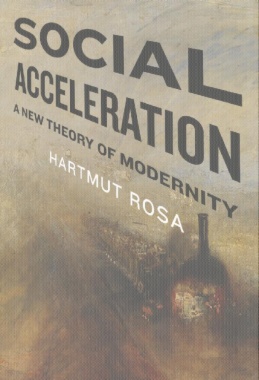Hartmut Rosa advances an account of the temporal structure of society from the perspective of critical theory. He identifies three categories of change in the tempo of modern social life: technological acceleration, evident in transportation, communication, and production; the acceleration of social change, reflected in cultural knowledge, social institutions, and personal relationships; and acceleration in the pace of life, which happens despite the expectation that technological change should increase an individual's free time.
According to Rosa, both the structural and cultural aspects of our institutions and practices are marked by the "shrinking of the present," a decreasing time period during which expectations based on past experience reliably match the future. When this phenomenon combines with technological acceleration and the increasing pace of life, time seems to flow ever faster, making our relationships to each other and the world fluid and problematic. It is as if we are standing on "slipping slopes," a steep social terrain that is itself in motion and in turn demands faster lives and technology. As Rosa deftly shows, this self-reinforcing feedback loop fundamentally determines the character of modern life.
- Contents
- Illustrations
- Translator's Introduction: Modernity and Time
- In Place of a Preface
- Introduction
- PART 1: The Categorial Framework of a Systematic Theory of Social Acceleration
- 1. From the Love of Movement to the Law of Acceleration: Observations of Modernity
- 1. Acceleration and the Culture of Modernity
- 2. Modernization, Acceleration, and Social Theory
- 2. What Is Social Acceleration?
- 1. Preliminary Considerations: Acceleration and Escalation
- 2. Three Dimensons of Social Acceleration
- 3. Five Categories of Inertia
- 4. On the Relation Between Movement and Inertia in Modernity
- PART 2: Mechanisms and Manifestations: A Phenomenology of Social Acceleration
- 3. Technical Acceleration and the Revolutionizing of the Space-Time Regime
- 4. Slipping Slopes: The Acceleration of Social Change and the Increase of Contingency
- 5. The Acceleration of the "Pace of Life" and Paradoxes in the Experience of Time
- 1. Objective Parameters: The Escalation of the Speed of Action
- 2. Subjective Parameters: The Pressure and the Experience of Racing Time
- 3. Temporal Structures and Self-Relations
- PART 3: Causes
- 6. The Speeding Up of Society as a Self-Propelling Process: The Circle of Acceleration
- 7. Acceleration and Growth: External Driving Forces of Social Acceleration
- 1. Time Is Money: The Economic Motor
- 2. The Promise of Acceleration: The Cultural Motor
- 3. The Temporalization of Complexity: The Socio-Structural Motor
- 8. Power, War, and Speed: The State and the Military as Key Institutional Accelerators
- PART 4: Consequences
- 9, Acceleration, Globalization, Postmodernity
- 10. Situational Identity: Of Drifters and Players
- 1. The Dynamization of the Self in Modernity
- 2. From Substantial A Priori Identity to Stable a Posteriori Identity: The Temporalization of Life
- 3. From Temporally Stable to Situational Identity: The Temporalization of Time
- 11. Situational Politics: Paradoxical Time Horizons Between Desynchronization and Disintegration
- 1. Time in Politics - Politics in Time
- 2. The Temporalization of History in the Modern Age
- 3. Paradoxical Time Horizons: The Detemporalization of History in Late Modernity
- 12. Acceleration and Rigidity: An Attempt to Redefine Modernity
- Conclusion: Frenetic Standstill? The End of History
- Notes
- Bibliography
- Index

